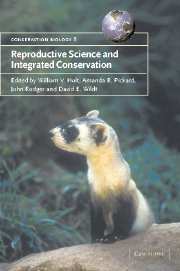Book contents
- Frontmatter
- Contents
- List of contributors
- Foreword
- Part I Introduction
- Part II Reproduction and population viability
- Part III Reproductive techniques for conservation management
- Part IV Integrated conservation management
- Part V Reproduction science in non-mammalian species
- 21 Reproductive technologies and challenges in avian conservation and management
- 22 Reptile reproduction and endocrinology
- 23 Reproductive research and the worldwide amphibian extinction crisis
- 24 Reproduction in fishes in relation to conservation
- Part VI Conclusions
- Index
- References
22 - Reptile reproduction and endocrinology
Published online by Cambridge University Press: 21 January 2010
- Frontmatter
- Contents
- List of contributors
- Foreword
- Part I Introduction
- Part II Reproduction and population viability
- Part III Reproductive techniques for conservation management
- Part IV Integrated conservation management
- Part V Reproduction science in non-mammalian species
- 21 Reproductive technologies and challenges in avian conservation and management
- 22 Reptile reproduction and endocrinology
- 23 Reproductive research and the worldwide amphibian extinction crisis
- 24 Reproduction in fishes in relation to conservation
- Part VI Conclusions
- Index
- References
Summary
INTRODUCTION AND BACKGROUND
The alarming pace of the global decline in amphibians has alerted both biologists and the general public to the accelerating rate of habitat loss, fragmentation and degradation (Roth & Obringer, Chapter 23). However, as Gibbons et al. (2000) recently pointed out, ‘Although the amphibian decline problem is a serious threat, reptiles appear to be in even greater danger of extinction worldwide.’ For example, one of the most spectacular and enigmatic reptiles, the leatherback sea turtle (Dermochelys coriacea) appears to be on a direct course for extinction, while little continues to be known of its unusual physiology and life history (Spotila et al., 1996). In fact, many reptile species are destined to disappear before anything is discovered of their basic biology, including reproduction.
Reptiles were the first truly terrestrial vertebrates. The evolution of the amniote egg, ‘the most marvelous “invention” in vertebrate history’ (Romer, 1967), freed reptiles from dependence on an aquatic environment for reproduction, thus allowing exploitation of terrestrial habitats. The increase in yolk mass, completion of development within an egg and abandonment of a larval stage resulted in an explosion of forms that typified the ‘age of reptiles’ during which at least 17 orders appeared.
Of this extraordinary diversity, only four orders remain today in the class Reptilia: Chelonia or Testudinata (turtles and tortoises, 260 species), Crocodilia (crocodiles, alligators and the gharial, 22 species), Squamata (snakes, lizards and amphisbaenids, >6800 species) and Rhynchocephalia or Sphenodontida (represented by the genus Sphenodon, the tuatara, two species).
- Type
- Chapter
- Information
- Reproductive Science and Integrated Conservation , pp. 338 - 358Publisher: Cambridge University PressPrint publication year: 2002



